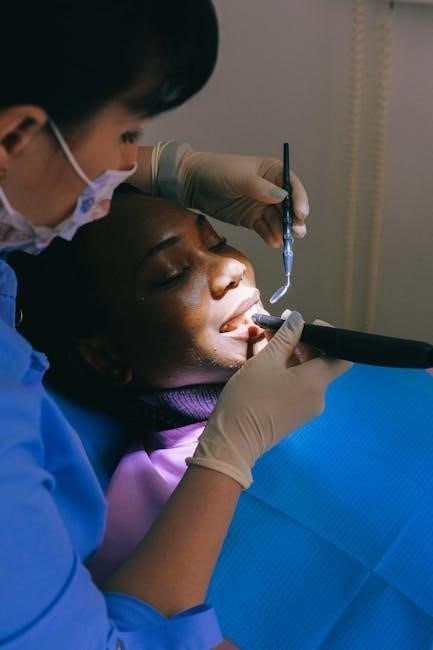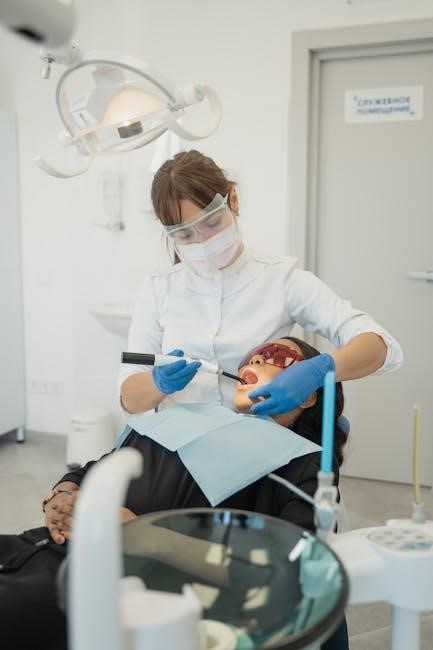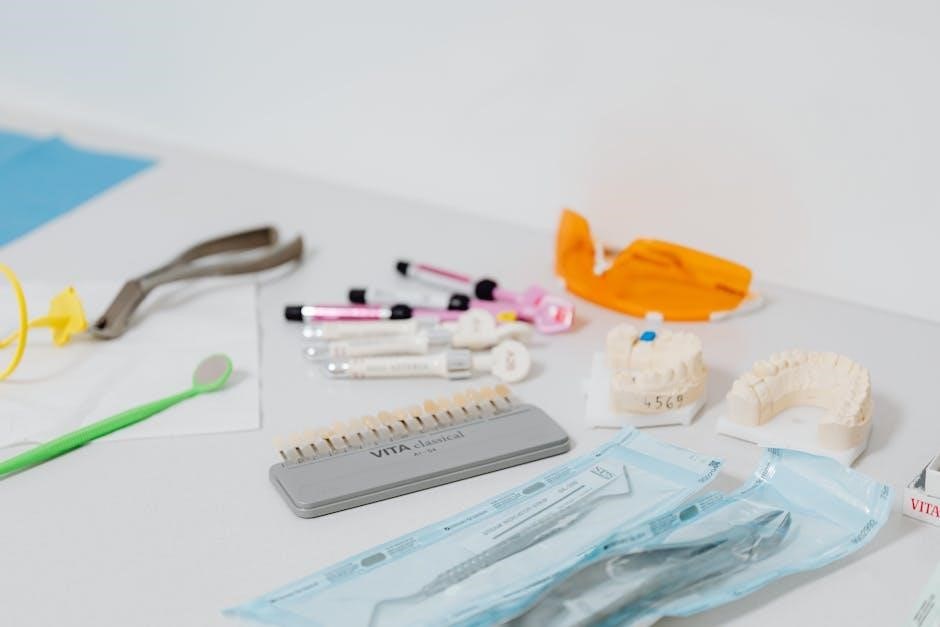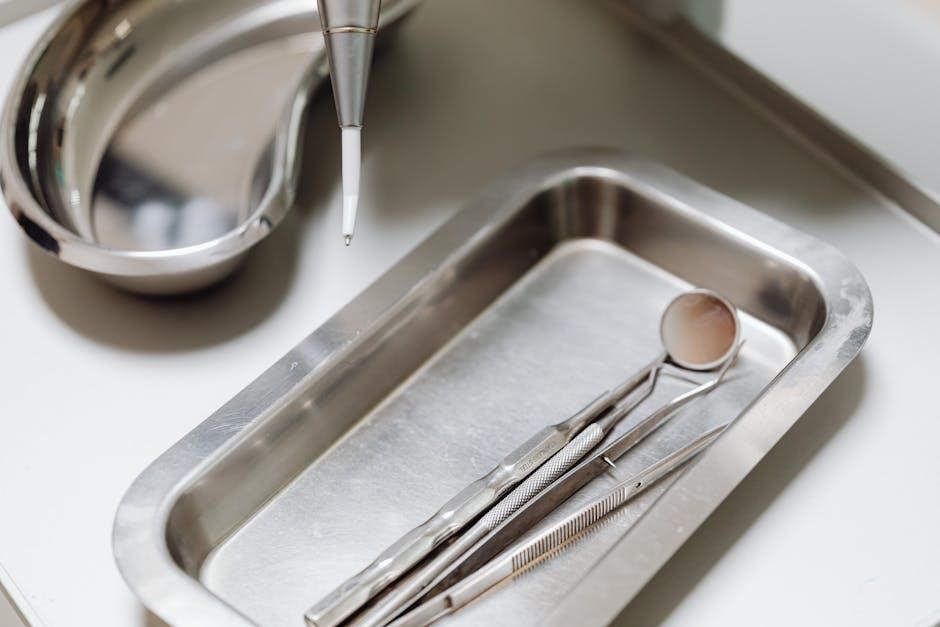
Guided surgery for dental implants is a modern, precise approach using 3D planning and surgical guides to ensure accurate implant placement, minimizing errors and reducing surgical time.
1.1 Definition and Overview
Guided surgery for dental implants is a modern surgical approach that utilizes detailed 3D digital planning and surgical guides to ensure precise implant placement. This method involves creating a customized template or guide based on the patient’s anatomy, which is derived from advanced imaging techniques like CBCT scans. The guide is then used during surgery to direct the placement of dental implants with high accuracy, typically within 1-2mm of the planned position. This approach minimizes human error, reduces surgical time, and enhances the predictability of outcomes. Guided surgery is particularly beneficial for complex cases, offering a high level of precision and patient-specific results, making it a significant advancement in implant dentistry.
1.2 Historical Development
The concept of guided surgery for dental implants has evolved significantly over the decades. The foundation of modern implantology was laid in the 1950s by Per-Ingvar Brånemark, who discovered osseointegration. Early implant placements were freehand, relying on the surgeon’s expertise. In the 1980s, the first surgical guides were introduced, marking the beginning of guided surgery. These early guides were rudimentary but paved the way for more advanced techniques. The 1990s saw the integration of cone beam computed tomography (CBCT) scans, enabling 3D imaging and improving the accuracy of implant placement. The development of CAD/CAM technology in the 2000s further refined surgical guides, allowing for precise customization. Today, guided surgery combines digital planning, advanced imaging, and surgical guides to achieve highly accurate and predictable outcomes, representing a significant leap from its humble beginnings.
How Guided Surgery Works
Guided surgery uses digital tools and surgical guides to streamline implant placement, ensuring precision and efficiency by translating pre-surgical plans into accurate, minimally invasive procedures.
2.1 Pre-Surgical Planning and Imaging
Pre-surgical planning is crucial for guided surgery, involving detailed 3D imaging to assess bone structure and tissue. Cone Beam Computed Tomography (CBCT) scans provide high-resolution images, enabling precise measurements and identification of anatomical landmarks. This data is used to create a digital model of the patient’s jaw, allowing surgeons to plan implant placement accurately. Specialized software, such as Exoplan or Implant Studio, facilitates virtual placement of implants, ensuring optimal positioning for aesthetics, function, and stability. The planning phase also accounts for prosthetic needs, ensuring a seamless transition to restoration. This step minimizes surgical complications and enhances outcomes, making guided surgery highly predictable and efficient. Advanced imaging ensures every detail is considered before the procedure begins.
2.2 The Role of Surgical Guides
Surgical guides are custom-made templates created from a patient’s 3D imaging data, ensuring precise implant placement. These guides are fabricated using 3D printing technology and are designed to fit the patient’s jaw anatomy perfectly. During surgery, the guide is placed over the jawbone, providing exact locations, angles, and depths for drilling and implant insertion. This reduces human error and enhances surgical accuracy. The guide acts as a bridge between the digital plan and the surgical execution, allowing for predictable outcomes. Surgical guides also help minimize complications by avoiding vital structures, such as nerves and sinuses. Their use streamlines the procedure, reducing surgical time and improving patient comfort. This tool is indispensable in modern guided surgery, ensuring implants are placed with optimal precision and reliability.

Benefits of Guided Surgery
Guided surgery enhances precision, reduces procedure time, and minimizes complications, offering predictable outcomes and improved patient satisfaction through accurate implant placement and streamlined surgical processes.
3.1 Increased Accuracy in Implant Placement
Guided surgery significantly enhances the precision of dental implant placement through detailed 3D planning and customized surgical guides; This approach ensures implants are positioned accurately, reducing errors and complications. By using advanced imaging and digital tools, surgeons can achieve placement within 2mm of the planned position, surpassing freehand techniques. The guides are tailored to the patient’s anatomy, ensuring optimal alignment and minimizing human error. This level of accuracy not only improves aesthetic and functional outcomes but also reduces the risk of nerve damage or improper fit. The precision of guided surgery fosters faster procedures and higher patient satisfaction, making it a preferred method for modern implantology.
3.2 Reduced Surgical Time
Guided surgery for dental implants significantly reduces surgical time by streamlining the procedure through precise pre-operative planning. The use of custom surgical guides ensures that each implant is placed in the exact predetermined position, eliminating trial and error. This minimizes adjustments during surgery and allows the surgeon to work efficiently. Advanced digital tools and 3D imaging enable the creation of detailed plans, which are executed with minimal deviation. Reduced surgical time not only benefits the patient by decreasing anesthesia exposure but also improves surgical workflow, making the process more predictable and stress-free for both the surgeon and the patient; This efficiency is a key advantage of guided surgery over traditional methods.

Key Technologies in Guided Surgery
Key technologies include Cone Beam CT (CBCT) for 3D imaging and CAD/CAM software for designing surgical guides, enabling precise implant placement and enhancing surgical accuracy.
4.1 Cone Beam Computed Tomography (CBCT)
Cone Beam Computed Tomography (CBCT) is a critical imaging technology in guided surgery, providing high-resolution 3D scans of the jawbone, teeth, and surrounding tissues. By capturing detailed cross-sectional images, CBCT allows precise pre-surgical planning, enabling dentists to identify optimal implant positions, avoiding vital structures like nerves and blood vessels. Its ability to visualize bone density and anatomy ensures accurate implant placement, reducing the risk of complications. Compared to traditional CT scans, CBCT offers lower radiation exposure and higher spatial resolution, making it a safer and more effective tool for dental implant planning. This technology is essential for creating surgical guides, ensuring implants are placed with maximum stability and aesthetic appeal.
4.2 CAD/CAM Technology
CAD/CAM (Computer-Aided Design/Computer-Aided Manufacturing) technology plays a pivotal role in guided surgery by enabling the creation of highly precise surgical guides. These guides are designed using detailed digital models generated from CBCT scans, ensuring optimal implant placement. CAD/CAM allows for the translation of complex surgical plans into physical templates, which guide the surgeon during implant insertion. This technology enhances accuracy, minimizes human error, and streamlines the surgical process. By integrating CAD/CAM with pre-surgical planning, dentists can achieve predictable outcomes, improve procedural efficiency, and ensure implants are placed in the most anatomically favorable positions. This level of precision is crucial for both functional and aesthetic success in dental implantology.

Comparison with Traditional Implant Surgery
Guided surgery offers enhanced accuracy and reduced surgical time compared to traditional freehand methods, overcoming limitations through precise 3D planning and minimally invasive techniques.
5.1 Advantages Over Freehand Surgery
Guided surgery offers significant advantages over freehand techniques, primarily through enhanced precision and predictability. By utilizing detailed 3D planning and surgical guides, it minimizes human error, ensuring implants are placed accurately within 2mm of the planned position. This reduces the risk of complications such as nerve damage or inadequate osseointegration. Additionally, guided surgery often results in shorter surgical times and less invasive procedures, improving patient comfort and recovery. The use of digital tools also allows for better aesthetic and functional outcomes, as the placement aligns with the patient’s specific anatomy and restoration goals. Overall, guided surgery provides a more controlled and efficient approach compared to traditional freehand methods.
5.2 Limitations and Challenges
Despite its advantages, guided surgery for dental implants has limitations. The process requires significant upfront investment in advanced technology, such as CBCT scanners and CAD/CAM software, increasing costs. Additionally, the accuracy of guided surgery heavily depends on the precision of the surgical guide, which can be compromised by factors like patient movement or improper fit. The complexity of creating detailed 3D plans also demands specialized training and experience, potentially limiting accessibility for less experienced surgeons. Furthermore, while guided surgery reduces errors, it does not eliminate them, as complications can still arise from inaccurate guide fabrication or unexpected anatomical variations. These challenges highlight the need for careful patient selection and skilled execution to maximize the benefits of guided implant surgery.

Factors Influencing the Success of Guided Surgery
Success in guided surgery relies on advanced technology, precise 3D planning, surgeon expertise, and patient suitability, ensuring optimal implant placement and predictable outcomes.
6.1 Patient Selection Criteria
Patient selection for guided surgery involves evaluating overall health, oral condition, and anatomical suitability. Ideal candidates have adequate bone density, good immune function, and are free from conditions that might hinder healing. Psychological readiness and commitment to post-surgical care are also crucial. Factors such as smoking, which can impair osseointegration, are considered. Patients with realistic expectations and a willingness to follow instructions are prioritized. Additionally, the presence of sufficient jawbone and appropriate gum health ensures the procedure’s success. Proper patient selection enhances outcomes and minimizes complications, making it a critical step in guided implant surgery. This careful evaluation ensures that only suitable candidates undergo the procedure, optimizing results and patient satisfaction. The criteria are tailored to individual needs, ensuring a personalized approach to implant placement.
6.2 Surgeon Experience and Skill
The success of guided surgery heavily depends on the surgeon’s experience and skill. Experienced surgeons possess a deep understanding of 3D planning tools and surgical guides, enabling precise implant placement. Their expertise allows them to handle complex anatomical challenges and minimize errors. Proper training in digital technologies is essential, as it ensures familiarity with software and equipment. Skilled surgeons can adapt to unexpected situations, ensuring optimal outcomes. Additionally, their ability to interpret CBCT scans and CAD/CAM designs accurately is crucial. The combination of technical proficiency and clinical judgment significantly enhances the predictability of results. Surgeons with extensive experience in guided surgery consistently achieve higher success rates and greater patient satisfaction. Their expertise directly impacts the procedure’s accuracy and long-term success, making it a cornerstone of guided implant surgery.
Potential Complications and Risks
Guided surgery, though precise, carries risks like nerve damage, bone loss, or sinus complications. Improper planning or execution can lead to implant misplacement or instability, affecting outcomes.
7.1 Common Surgical Complications
While guided surgery enhances precision, complications can arise, including nerve damage, sinus perforation, or implant instability. Nerve damage may cause temporary or permanent numbness, while sinus issues can lead to infection. Implant instability often results from inadequate bone density or improper placement. Bleeding, swelling, or discomfort are common post-surgical side effects. In rare cases, the surgical guide may malfunction, affecting accuracy. Additionally, bone loss or gum recession can occur if the implant fails to integrate properly. These complications highlight the importance of precise planning, experienced surgeons, and proper patient selection to minimize risks and ensure successful outcomes. Regular follow-ups are crucial to address any post-surgical concerns promptly.
7.2 Strategies for Risk Mitigation
To mitigate risks in guided implant surgery, thorough pre-surgical planning using CBCT and CAD/CAM technology is essential for accurate 3D visualization. Experienced surgeons should implement customized surgical guides to enhance precision. Proper patient selection, considering bone density and overall health, minimizes complications. Adhering to sterile protocols during surgery reduces infection risks. Post-operative care, including monitoring and patient education, ensures proper healing and implant integration. Regular follow-ups help identify and address potential issues early. By combining advanced technology with meticulous planning and skilled execution, the likelihood of complications is significantly reduced, leading to successful and predictable outcomes for patients.
Cost Considerations
Guided surgery for dental implants involves higher initial costs due to advanced technology and specialized guides, but long-term benefits often justify the investment for patients.
8.1 Factors Affecting the Cost
The cost of guided surgery for dental implants is influenced by several factors, including the complexity of the case, the surgeon’s expertise, and the technology used. Advanced imaging techniques like CBCT and CAD/CAM technology contribute to higher expenses. Additionally, the location of the clinic and the number of implants required can significantly impact the total cost. Patients with complex anatomical conditions may require custom surgical guides, further increasing the price. Insurance coverage varies, and while some plans may cover part of the procedure, others may not, making it important to consult with both the surgeon and insurance provider. These variables make the cost of guided surgery highly individualized.
8.2 Insurance Coverage and Payment Options
Insurance coverage for guided surgery for dental implants varies widely, as some policies may cover it under major dental procedures, while others may not. Patients are advised to review their insurance plans and consult with their providers to determine the extent of coverage. Many clinics offer financing options, such as payment plans or credit arrangements, to make the procedure more accessible. Additionally, third-party financing companies specialize in medical and dental loans, providing flexible repayment terms. Some institutions also offer discounts for multiple implant placements, further reducing the financial burden. It is essential for patients to discuss payment options with their healthcare provider to find a solution that fits their budget and needs.

Case Studies and Real-World Applications
Guided surgery for dental implants has demonstrated success in real-world applications, with case studies highlighting improved accuracy and patient satisfaction in complex implant placements and full-mouth reconstructions.
9.1 Successful Outcomes
Guided surgery for dental implants has consistently delivered high success rates, with studies showing implant placement accuracy within 2mm, significantly reducing complications. Patients benefiting from this approach often experience improved aesthetic and functional outcomes, particularly in complex cases involving full-mouth reconstructions or bone deficiency. The precision enabled by 3D planning and surgical guides ensures optimal implant positioning, leading to higher patient satisfaction and long-term stability. Real-world applications highlight how guided surgery minimizes surgical time and post-operative recovery, making it a preferred choice for both clinicians and patients seeking reliable and predictable results in dental implantology.
9.2 Lessons Learned from Complex Cases
Complex cases in guided surgery for dental implants highlight the importance of precise pre-surgical planning and the integration of advanced technologies. Challenges such as anatomical limitations, bone density issues, and implant positioning in aesthetically sensitive areas have taught clinicians the value of customized surgical guides. These cases often require meticulous 3D planning to avoid critical structures and ensure optimal implant placement. Experience from such cases underscores the need for patient-specific solutions and the importance of surgeon expertise in interpreting CBCT scans and CAD/CAM designs. Additionally, complex cases have shown that guided surgery can minimize complications, even in scenarios with limited bone availability, emphasizing its reliability for achieving successful outcomes in challenging situations.
Future Trends in Guided Surgery
Future trends include advancements in AI-driven implant placement, real-time navigation systems, and enhanced CAD/CAM technologies, promising even greater precision and efficiency in guided dental implant procedures.
10.1 Advances in Digital Technology
One of the key future trends in guided surgery is the continuous evolution of digital technologies. Advanced software and hardware are enabling more precise 3D planning and real-time tracking during procedures. For instance, next-generation CAD/CAM systems are expected to offer enhanced customization options, allowing for implants and surgical guides to be tailored even more specifically to individual patient needs. Additionally, the integration of augmented reality (AR) and virtual reality (VR) into guided surgery could revolutionize how surgeons visualize and execute implant placements. These technologies may also facilitate better communication between surgeons and patients, improving overall treatment outcomes. As digital tools become more sophisticated, the accuracy and efficiency of guided surgery are likely to increase significantly.
10.2 Integration with Artificial Intelligence
The integration of artificial intelligence (AI) into guided surgery represents a transformative leap forward. AI algorithms can analyze vast amounts of patient data, such as CBCT scans and medical histories, to predict optimal implant placements and outcomes. Machine learning models can identify patterns and anomalies, helping surgeons avoid potential complications. AI-driven tools may also enable real-time adjustments during surgery, ensuring even greater precision. Furthermore, AI could streamline pre-surgical planning by automating the design of surgical guides and implants. As AI technology advances, it is expected to enhance the reliability and efficiency of guided surgery, potentially leading to fully autonomous surgical systems in the future. This integration promises to redefine the standards of dental implant procedures.
Guided surgery for dental implants is a significant advancement, offering precision, efficiency, and improved outcomes. Its future promises further innovation and enhanced patient care.
11.1 Summary of Key Points
Guided surgery for dental implants combines advanced technologies like CBCT and CAD/CAM to ensure precise implant placement, reducing errors and surgical time. It offers superior accuracy compared to freehand methods, improving esthetic and functional outcomes. By integrating digital tools, guided surgery streamlines pre-surgical planning and execution, enabling customized solutions for patients. The use of surgical guides enhances predictability and minimizes complications. Overall, guided surgery represents a significant leap forward in dental implantology, offering patients reliable, efficient, and visually appealing results while setting a new standard for modern implant procedures.
11.2 Final Thoughts on the Future of Guided Surgery
Guided surgery for dental implants is poised for significant advancements, driven by emerging technologies like artificial intelligence and real-time tracking systems. Integration of AI will enhance pre-surgical planning, enabling more precise predictions and personalized treatments. Machine learning algorithms could optimize implant placement based on vast datasets, improving outcomes. Additionally, advancements in real-time navigation systems will allow for dynamic adjustments during surgery, further increasing accuracy. These innovations promise to make guided surgery more accessible, efficient, and patient-centric. As digital tools continue to evolve, guided surgery will likely become the standard of care, offering unparalleled precision and reliability in dental implantology. The future holds immense potential for transforming implant procedures, ensuring better results for patients worldwide.